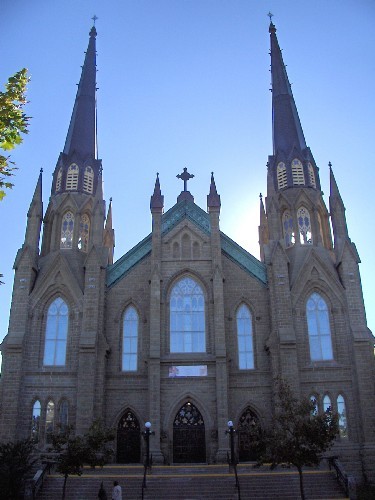Other Name(s)
St. Dunstan's Roman Catholic Cathedral / Basilica National Historic Site of Canada
St. Dunstan’s Basilica
Basilique St. Dunstan
Links and documents
n/a
Construction Date(s)
1896/01/01 to 1907/01/01
Listed on the Canadian Register:
2006/12/20
 Statement of Significance
Statement of Significance
Description of Historic Place
St. Dunstan’s Roman Catholic Cathedral National Historic Site of Canada is a large, stone church in the centre of Charlottetown, Prince Edward Island. Set on the lawns of a well-treed ecclesiastical precinct next to a large stone bishop’s palace, its imposing bulk, masonry construction, and Gothic Revival style towers, pinnacles, and triple portal facade create an imposing presence on Great George Street.
Heritage Value
St. Dunstan's Roman Catholic Cathedral was designated a national historic site of Canada because it is a fine representative example of the High Victorian Gothic Revival style of architecture.
Designed and built in the French-inspired interpretation of the High Victorian Gothic Revival style by Quebec architect Francois-Xavier Berlinguet in 1896-1907, the cathedral suffered extensive fire damage in 1913 after which its interior was substantially redesigned and rebuilt in a more English-inspired idiom by architect J. M Hunter. St. Dunstan's is the centre of the Roman Catholic church in Prince Edward Island and the mother church of the diocese. It was consecrated and elevated to the status of Basilica in 1929.
Source: Historic Sites and Monuments Board of Canada, Minutes, 1990: Commemorative Integrity Statement.
Character-Defining Elements
Key elements of the site include:
- the High Victorian Gothic Revival stylistic characteristics including irregular massing, the twin-towered facade with tall, slender pinnacles, stained glass windows, and picturesque roofline;
- late French Gothic stylistic characteristics on the exterior including the broad, three-bay, two-storey facade defined by piers and stringcourses with large traceried windows between the piers, triple portal entry, and polygonal apse with surrounding sacristy;
- the English Gothic stylistic influence on the interior plan and decoration with its cruciform plan with narthex, short nave with side aisle, crossing, wide transepts, and large sanctuary, triforium, clerestory, piers of clustered shafts and foliated capitals supporting broad Gothic arches of the nave arcade, and light ribbed vaulting with a pattern of eight-pointed stars along the crown of the nave vault,
- the stone building materials,
- the imposing siting of the church within an ecclesiastical precinct, facing Great George Street.
 Recognition
Recognition
Jurisdiction
Federal
Recognition Authority
Government of Canada
Recognition Statute
Historic Sites and Monuments Act
Recognition Type
National Historic Site of Canada
Recognition Date
1990/02/23
 Historical Information
Historical Information
Significant Date(s)
1913/01/01 to 1913/01/01
1929/01/01 to 1929/01/01
Theme - Category and Type
- Building Social and Community Life
- Religious Institutions
- Expressing Intellectual and Cultural Life
- Architecture and Design
Function - Category and Type
Current
- Religion, Ritual and Funeral
- Religious Facility or Place of Worship
Historic
Architect / Designer
Francois -Xavier Berlinguet
Builder
n/a
 Additional Information
Additional Information
Location of Supporting Documentation
National Historic Sites Directorate, Canadian Inventory of Historic Building Documentation Centre, 5th Floor, Room 525, 25 Eddy Street, Hull, Quebec
Cross-Reference to Collection
Fed/Prov/Terr Identifier
581
Status
Published
Related Places

St. Dunstan's Basilica
St. Dunstan's Cathedral Basilica is a stone French Gothic church built in 1913 from the remains of the cathedral that had been damaged by fire that year. St. Dunstan's is the…